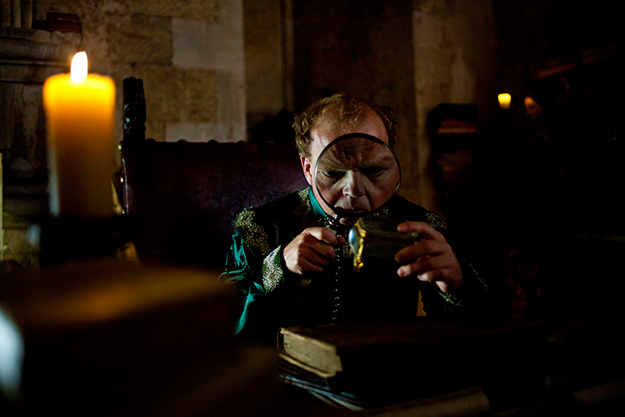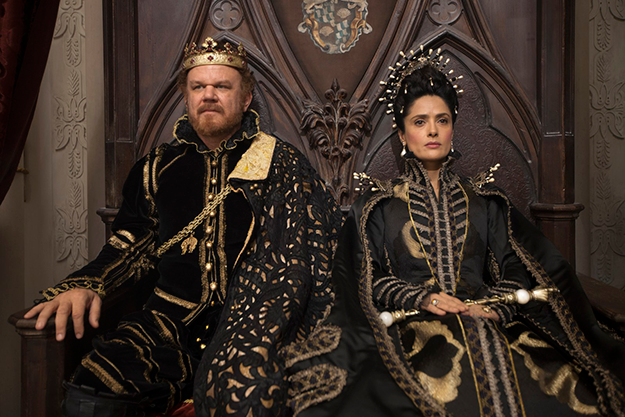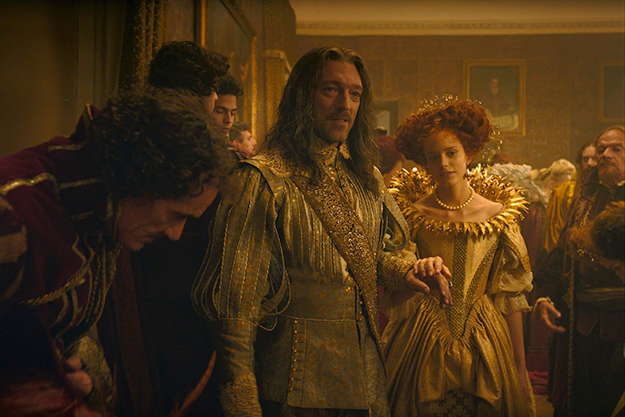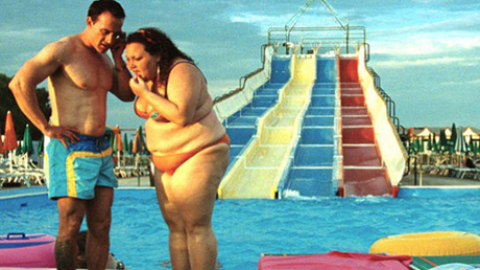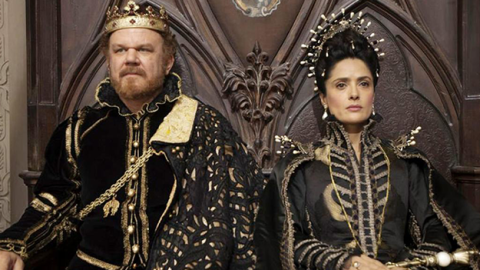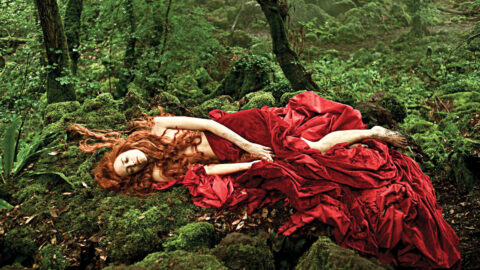Deep Focus: Tale of Tales
Matteo Garrone’s erotic, gory, and imaginative Tale of Tales freely adapts three stories from Giambattista Basile’s 50-fairy-tale collection Lo cunto de li cunti. The movie, like the stories, unfolds in a ribald Neverland that’s part paradise and part hell, where a witch can transform a crone into a lissome beauty and a giant cannibalistic brute can wed a sheltered storybook princess. Basile’s original two-volume tome, published posthumously in 1634 and 1636, and also known as The Pentamerone, became an inspiration for the Brothers Grimm (and many others) because it put earthy oral traditions into exuberant literary form. Basile wrote his tales in the Neapolitan dialect and set them in southern Italy. Garrone has rendered them in English with the polyglot accents of an international cast including France’s Vincent Cassel and England’s Toby Jones. The effect is aptly odd and beguiling. It’s as if Garrone is declaring that any taint of vulgar realism has no place in his film. And the director has combed present-day southern Italy for magical locales, like Castello di Roccascalegna, a fortress that sits on a ledge and looks as if it’s leaning on air.
Working with the inspired cinematographer Peter Suschitzky (whose credits include The Empire Strikes Back and 11 films with David Cronenberg), Garrone achieves a stupendous combination of worldliness and other-worldliness. Fantastical real places, including the crystallized lava gorges and ravines surrounding the Alcantara River, merge seamlessly with Dimitri Capuani’s extravagant production designs. They provide ideal settings for outlandish actions, ranging from a battle with an ogre in a craggy mountain pass to an orgy in a secluded grotto. The overall look is Nouveau Medieval—a more vivid and accomplished version of the visual mash-up Roger Vadim sought in his softcore-porn episode of the Poe anthology film, Spirits of the Dead. This movie is too gleefully eclectic to pin down. When John C. Reilly, as the King of Longtrellis, dons a metal diving helmet, he looks like he stepped out of 20,000 Leagues Under the Sea. It’s an elegant steam-punk touch in a production replete with marvels big and small.
Garrone and his co-writers intercut three Basile fables, “The Enchanted Doe,” “The Flea,” and “The Flayed Old Lady.” In the first, Reilly’s King of Longtrellis is desperate to de-gloom his wife (Salma Hayek), who aches to bear a child. He follows a necromancer’s three-step program: slay a sea monster, cut out its heart, and locate a virgin to cook it for the queen. While feasting on the heart, the queen conceives a child; the steam from the cooking pot alone impregnates the virgin. The queen and the cook, within a day, deliver identical albino boys, who become inseparable in youth (and are played by Jonah and Christian Lees). Garrone’s treatment of Basile’s “The Enchanted Doe” epitomizes how freely and creatively he and his cowriters have adapted the author’s work. In their version, for example, there’s no enchanted doe. The crucial narrative beats are not spectacular but emotional. The King dies fighting the aquatic critter (a great white fleshy thing that moves with terrifying gravity), but the Queen is blasé about his death. She stays focused on the prospect of a child, becomes alarmingly possessive after she does give birth to a son. She spills over with comic pathos when he eludes her in a garden labyrinth; she turns frightening when she goes on the rampage against his twin after she learns the boy has pulled off posing as her child.
As these two lads contemplate swapping identities day to day, you expect to see a variation on The Prince and the Pauper (and Garrone’s open-ended sensibility welcomes all interpretations and allusions). But the fable gets wilder and weirder than that. It isn’t about upending hierarchies but about the fearsome intimacy of twins and how that can threaten even a royal mother. The non-aristocratic lad, fearful of the Queen, decides to strike out for the provinces. But first he buries his sword in the ground and summons a spring. He tells his friend that if the water stays clear, he’s doing well. Their brotherhood seems rooted in the earth. The spring keeps their closeness alive. What’s even more eerie (and original to the film) is how viciously the Queen’s already warped maternal instinct warps into black magic and wars with the boys’ fraternal love. The kings may be the catalysts in these stories, but their women supply the film with its trifurcated spine and embody its dizzying contradictions.
The necromancer sets the stage for the entire movie when he warns Reilly and Hayek’s ruling couple that death and birth are intertwined. He expresses a fairy-tale version of Newton’s Third Law of Physics: that for every action there is an opposite and equal reaction. But the movie is never mechanical. Each act of will has a consequence, but it can’t be predicted or even easily traced. In “The Flea,” another monarch, the self-absorbed King of Highhills (Jones), nurtures a talented flea more lovingly than he does his sweet, obedient daughter Violet (Bebe Cave). He feeds the insect his own blood and then raw meat, until it grows to the size of a lamb. The plot looks back to Ovid and ahead to Kafka. But the story is about what happens after the flea dies. The King mounts its hide in one of his halls and declares that whoever guesses the kind of skin will win his daughter’s hand. When an ogre takes one huge sniff and in a horrific-comic highpoint declares, “flea,” the princess rebels for the first time. But her father insists that if he, the king, set this plot in motion, the outcome must be just, so the poor girl must let the ogre carry her away. The episode turns on her resilience and surprising ferocity. It’s both an attack on tottering, narcissistic patriarchy and a salute to a young girl grabbing her own hegemony with both hands—especially her knife hand.
Violet gains strength from a crucible of blood, but the title character of “The Flayed Old Lady” is (as you might guess) not so lucky. In a glorious funny-sad performance, Shirley Henderson plays Imma, who with her equally reclusive and scrofulous sister Dora (Hayley Carmichael) lives just a spitting distance from the degenerate King of Strongcliff (Cassel). Entranced by Dora’s singing and convinced that her voice must belong to a great beauty, the King comes courting before he ever sees more than the back of Dora’s head. This story offers one bold or fabulous stroke after another, from the king kissing and caressing Imma’s finger through a hole in their door to her performing Dark Ages cosmetic surgery on Dora before she makes her way to the king’s bed in utter darkness. Dora experiences humiliation, transformation, and glory that leave Imma befuddled and envious—and determined, in the worst way possible, to change her skin. Carmichael is amusingly, touchingly desperate as Dora (and Stacy Martin is svelte and appealing as the younger Dora), but the sight of Henderson wandering through the court in a gown whose jewel-encrusted neck is all askew recalls Charlie Chaplin or Giulietta Masina. Her horrifying final appearance illustrates, with a terrible irony, the character’s belief that (as Basile put it) “she who wants to appear beautiful must suffer.” A story that begins with the lilt and poignancy of the young Federico Fellini ends on the serrated edge of Luis Buñuel.
Garrone ditches the book’s intricate, Arabian Nights–like framing story. He links the characters only by showing them attending the King of Longtrellis’s funeral early on and Violet’s coronation at the climax. In between he leaps intuitively from story to story, as if striving to achieve what Griffith did in Intolerance—a series of exhilarating crescendos. He doesn’t: the film is slack in the middle. But it’s not ragged around the edges. It’s glorious around the edges. Garrone’s ambition is continually intriguing and what he does achieve is often elating enough.
Although he’s best known for his naturalistic gangster film Gomorrah (08), which also juggled multiple storylines, Tale of Tales more closely resembles his last film, Reality (12), an absurdist satire of media-saturated life about a Neapolitan fishmonger who dedicates himself to appearing on the Italian version of Big Brother. Reality isn’t only an attack on media celebrity as the new religion, and it’s not merely an attack on old religions that make people behave well because they think God is watching. It’s about the poisonous sentimentality of our Western greeting-card pop culture, with all its bromides about having faith and following our dreams. And it’s about the trap of magical thinking.
In Tale of Tales, which could be called Surreality, Garrone views several strains of magical thought as realities that must be mastered. This movie does what Into the Woods failed to do: it still makes you believe in sorcerers, witches, and trolls, though it undercuts the certainty that heroes and heroines live happily every after. Garrone doesn’t blow his budget on photo-realistic effects; he succeeds in conjuring a magical feeling, whether by exploiting the wonders of an octagonal castle, creating actual creatures for the sea monster and the lamb-sized flea, or staging human metamorphoses with stunning simplicity. He makes you feel as if you’ve stepped into a world where fickle gods play crack-the-whip with man’s—and woman’s—fate.
Michael Sragow is a contributing editor to FILM COMMENT and writes its Deep Focus column. He is a member of the National Society of Film Critics and the Los Angeles Film Critics Association. He also curates “The Moviegoer” at the Library of America website.



